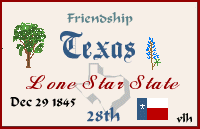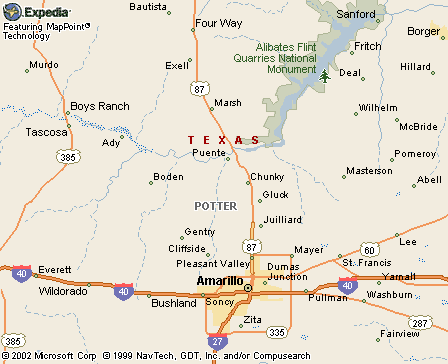Welcome To Amarillo Texas!






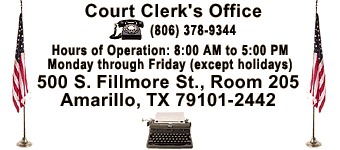

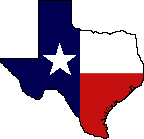 Howdy Folks! Welcome to The High Plains.
Howdy Folks! Welcome to The High Plains.
Free Genealogy Search!




Our story begins in the dawn of early settlement.
This area was a favorite camping site for both prehistoric groups such
as the Pueblo who anthropologists term as being associated with the
Antelope Creek phase, to those arriving later such as the Apache who
were later forced to leave by others.
These tribes often inhabited nearby in search of Buffalo, and the
Comanche Indians in particular were known to appreciate
Wild Horse Lake
for the purposes of obtaining much needed water.
After they were forcibly removed by the U.S. Army (that
ended the Red River War of 1874-1875), the land soon became open
to settlement following these events.
This soon caught the eye of some and in 1877 the LX
was established on what became known as Ranch Creek near the
northern banks of the Canadian River, while part of the LIT was nearby
to the west.
In 1880 there were just three spreads listed and
28
souls. And while there were no crops reported, noted were 14,000 head
of cattle and 4,200 sheep!
In 1881 the Frying Pan was established with its headquarters on
Tecovas Spring. This location was an accepted trading spot, particularly for
the Comancheros, and later for the New Mexican Sheepherders as well.
As it turned out, their bookkeeper was named Warren
Wetzel and he became the first Mayor. It also
is important to note that his wife Katherine was the only woman here
for nearly six years!
1887 hailed the construction of the Fort Worth and Denver
Railway, which quickly became very attractive to settlers.
Overnight a construction camp working on the Railroad turned into a
village of tents and huts that became known as Ragtown. Soon
little colonies
began popping up all over which included a place known
as Oneida.
During this time, several small municipalities were attempting to become
the
seat of government.
Voting was soon the result, and Oneida won out. The name was then
changed, and a Post Office was soon in full operation
within the next month!
The first newspaper started in May of 1888 which was called the
Champion. This was soon followed by a school built in that very
same year.
By 1890, due to worries of potential flooding, the town was moved to
higher ground to a location just a little bit further east. This new place
was believed to be safer during downpours.
Growth was quite substantial during these early years and business
was soon booming, becoming a vital hub for the
cattle industry due to the RR and the granges.
In 1890 there were now twenty homesteads and
more than 44,000 head of steer and no sheep, with an
increase that was listed at over 1,820 souls.
In 1899 the Santa Fe line established an office which included
an
eight-stall engine house, a blacksmith and machine shop.
After 1904 there were three new rail lines which were comprised of the
Southern Kansas, Pecos & Northern and the Choctaw,
Oklahoma Railroad.
In 1908, the Santa Fe ran a line to Canyon and Lubbock,
which enhanced the transportation structure.
Over the years the old homesteads became divided and sold as the
numbers of citizens
increased. Soon the large granges became subdivided,
which
brought many farmers here who came via the train.
In 1900, the number was 1,442, and it steadily increased
to over 5,000 by 1906, and to 9,957 by 1910.
At this time, 162 farms were listed which was more than
double the number listed in the previous decade, and in a very short time
became vital for the farming industry while raising steers was still
leading as the largest contributor to the local economics.
Soon thereafter, the railways began encouraging more property
subdivisions with the establishment of agricultural demonstration
centers and
the hiring of agents in hopes of attracting those
interested. This soon led to excursion trains
from locations such as Chicago and elsewhere bringing lots of individuals
right here for the purpose of raising crops.
More economic boom times were soon on the horizon. In the year 1918
the discovery of the largest Natural Gas field in the entire world was
found just 25 miles northwest!
This good fortune was again repeated in 1926 when huge oil deposits
were
found in nearby Hutchinson Co. This resulted in several major
companies within the petroleum industry coming and
setting up shop.
Companies such as Phillips, Shamrock Oil & Gas, Magnolia Petroleum
Company and Texaco who had built a large refinery soon began operating in full swing.
This was soon followed by the discovery of Helium Production,
later Zinc smelting became very important.
This combination of events soon led to the establishment of small
villages along
the rail lines which included Bushland, Cliffside, Ady, Soncy, Pullman &
St.
Francis.
Sadly, in the 1930's, hard times hit when several oil companies
folded due to the Great Depression.
Farmers had a tough time when many crops were devastated by the
droughts that became known as the Dust Bowl, when the
skies
were darkened and turned day into night. Many families suffered
terribly during these horrific times, some to the point of near starvation.
In 1932 there were 14 dust storms; in 1933,
thirty-eight;
in 1934, twenty-two; in 1935, forty; in 1936, sixty-eight; in 1937,
seventy-two; in 1938, sixty-one; in 1939, thirty; in 1940, seventeen; in
1941, seventeen.
it was reported that in
1935 that these terrible storms lasted more than 908 hours!
Seven times during this year, the visibility was virtually zero. One notable
blackout lasted no less than eleven hours straight and in another
instance a single storm lasted for 3 and 1/2 days!
In '35 these "Black Blizzards" appeared with
sand
reaching as high as 8,000 feet. This was very
damaging to
the soils and caused immense economic loss.
There was terrible hardship during these times. Many who
came down sick during these horrific storms developed later illnesses,
some with permanent eye and lung damage, while others suffered
respiratory diseases during these times.
Many elderly, as well as small children and babies died as a result.
But there was a bright ray of sunshine in the '30s through Cal Farley
who set up the Maverick Boys Club which has proven to have helped
many a youth over the years.
His loving work later resulted in his
Boys Ranch on the old site of Tascosa.
The organization was overseen by Ralph Dykeman, and
Chanslor Weymouth and these men helped many of the local youth
achieve
honor and dignity that they have carried on through their lives.
Better times were coming in the '40s as a result of the
Federal New Deal programs that helped many by creating jobs
and providing a way for families to feed their children through employment.
Some of these programs such as the WPA or Work Projects
Administration
proved to be of vital importance for many residents.
The WPA proved to be a lifeline and many over the years
have said that this program saved them.
These jobs included such things as improvements on streets,
building of
schools, and many other important civic needs that contributed
greatly to the emotional and physical well-being of many residents.
These programs proved to be a lifesaver for over 600,000
in this
State alone!
By the 1940's the region began recovering as agriculture began a
steady
rise, and the economy was also boosted by the establishment of the
Army Air Field in 1942 and the later Pantex Munitions Plant.
This indeed
brought a much-needed boost to the post Dust Bowl era and
also led to many civilian jobs.
By the 1950's, the Country Music scene was jumping, and the
Downtown Jamboree was hosted right here by noted
personality Bozo Darnell.
He in fact lived down the street, and my mother and
grandfather
along with cousins were close with him,
and often appeared on television with him during these years where they
entertained as a duet and were regulars on the
Jamboree that he hosted in the early 50's.
We were honored to be among the first to hear most of his early
tunes long before they were ever released to the public. This was
due to his friendship with my kin who often sang
and
played songs with him during those years that the show was an
important
part of the entertainment scene here.
My folks were also well acquainted with Alexander Campbell "Eck" Robertson
who owned a shop on E. 10th Street where he reparied musical instruments.
My mom and Uncle Troy Lindsey who was a wonderful guitar player
would often stop by to visit and listen to him tune up fiddles when they were young.
He published the first commercial Country Album ever produced by the Victor
Talking Machine Company where he played his songs "Arkansas Traveler" and
"Turkey In The Straw" as well as "Sallie Goodin".
Well known artists such as Mark O'Conner and Bob Wills credited him with being a
major influence on their lives as musicians.
Up until his death in 1975, he maintained that the Victor Company had treated him unfairly.
One of the fastest growing cities in America during the 1950's, growth
and prosperity continued until the closure of the Air Base in 1968 by
Lyndon Baines Johnson. It was believed by many that it
was closed due to failure of the populace to vote for him during an
election.
The closure resulted in a dramatic economic blow to the
area and the numbers dropped from 115,580 in 1960 to 90,511 as
demonstrated by the 1970 enumeration. This major drop
has been attributed to the
order by Johnson and great resentment was a result.
Over the years the vicinity became very important as a hub to the trucking
industry, and is often known by old timers as the Crossroads of America
due to the fact that Four U.S. Highways - 60, 87, 287, and the fabled
Route 66 - all merged right here!
My Grandfather Joseph C. Weaver worked at ICX Motor
Freight
Company, and he and my grandmother together operated a successful
and well known
Flea Market on Fillmore Street for many years. Many may
remember my
Papa Joe for his fantastic playing of the french harp which always
drew a
crowd to his establishment for quite a long time.
My Mama Rene was employed at Maynard Sash & Door and also worked
at the AQHA. She was a fantastic gardener and
a wonderful cook. I still dream of her delicious fried okra and her home
canned black-eyed peas.
In the early 1940's my Grandpa was a heavyweight Golden Gloves Boxer
and was good buddies with Ray Jackson who operated the Hobby
House Gym on W. 6th Street where he fought matches for a number of years.
In addition to this, my mother was best pals with the daughter of a
professional Wrestler called Tuffy Truesdale back in those days.
Mama was a regular visitor of Wrestling matches during that time and was well
acquainted with Dory Funk and the other local sports legends of that era.
During these years the city was very well known for its excellent sponsorship of
major sporting events which produced big celebrities such as Dick Murdoch and
others that later wound up being recognized around the world for their talent.
In the 1980's Interstate 27 was built and this further added additional
easy
access for such things as trucking and local commerce.
This area is attractive due to locations such as Lake
Meredith and the Alibates Flint Quarries, and also benefits
tourism associated with the Palo Duro Canyon State Park which is
known for its production of a fantastic musical drama.
The staked plains has been home to many known
around the world. Bat Masterson & Billy the Kid,
Will Rogers and Rick Husband, our city is one of those places where
citizens are happy to
hang their hat.
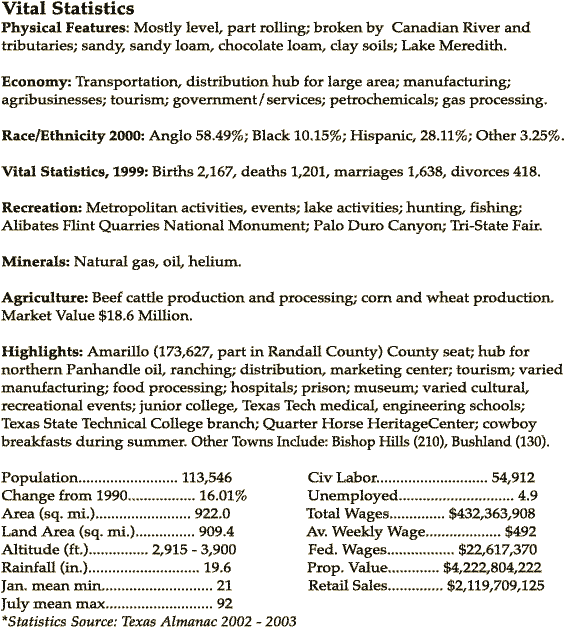
Towns Include:
Ady
Aqua (Bennie)
Bishop Hills
Boden
Bushland
Chunky
Cliffside
Excel
Folsom
Gentry
Gluck
James
Julliard
Marsh
Masterson
Mayer
Nagiller
Noble
North Heights
Oneida
Pleasant Valley
Puente
Pullman
Rolling Hills
Saint Francis
Soncy
Tascosa Hills
Walnut Hills
Wheeler




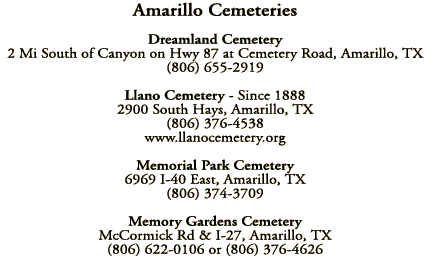

Our Neighbors
Randall
All County List!



 Darren McCathern
Project Coordinator
Darren McCathern
Project Coordinator


Privacy Policy
© 2024 All Rights Reserved.








